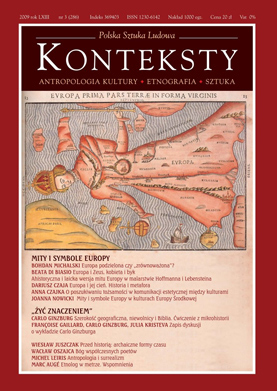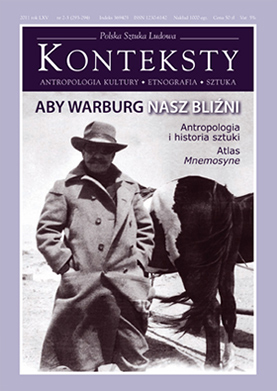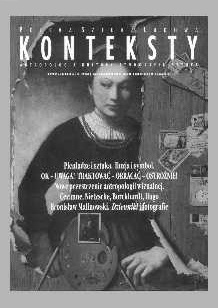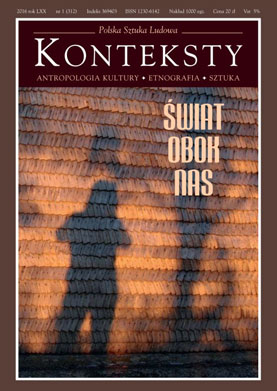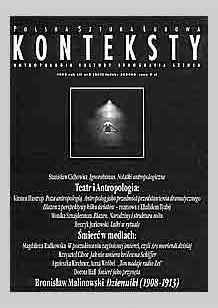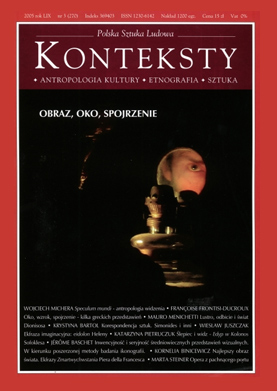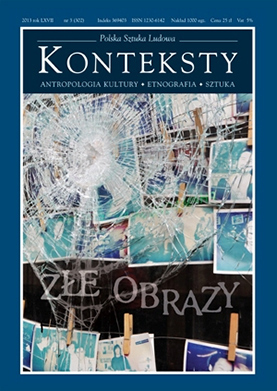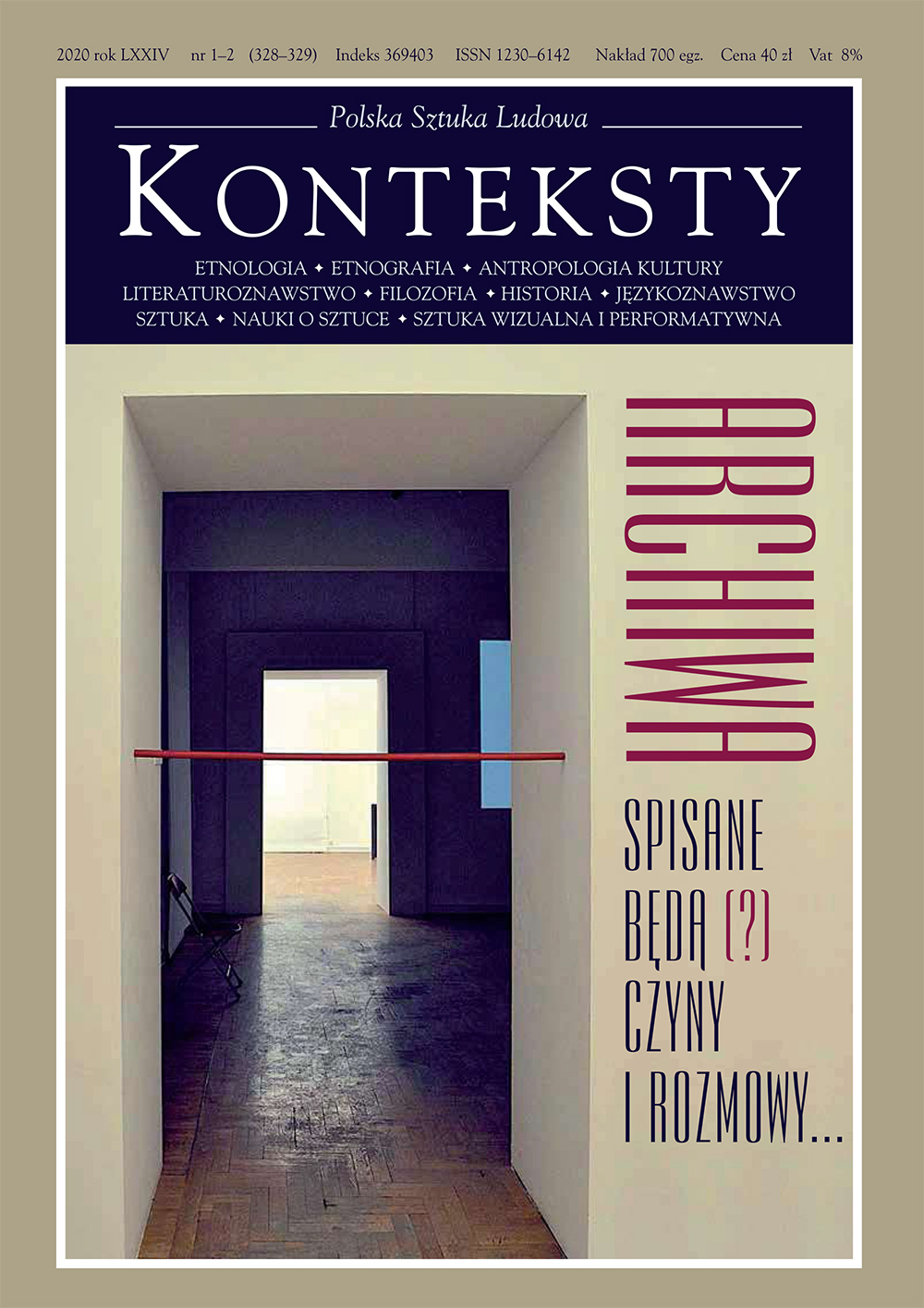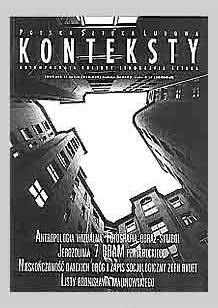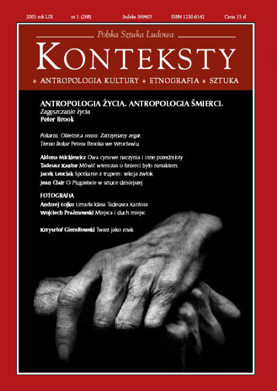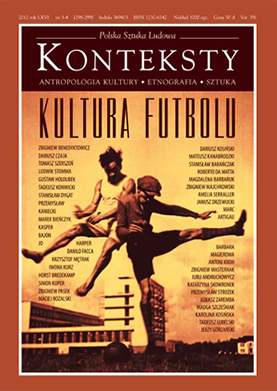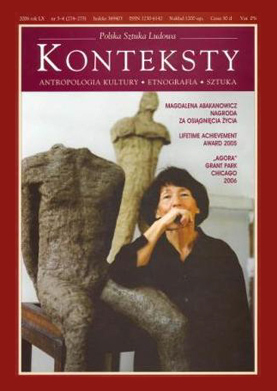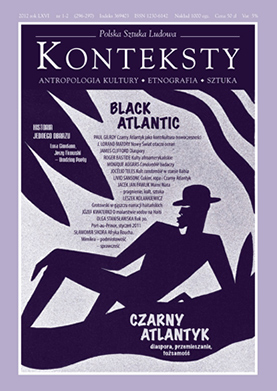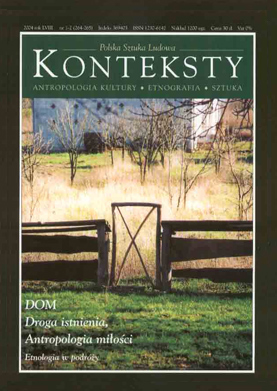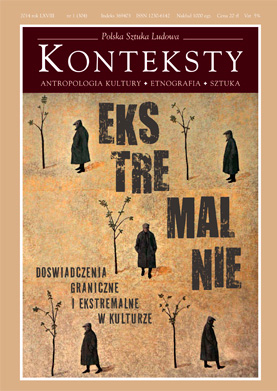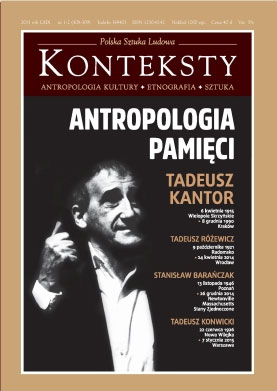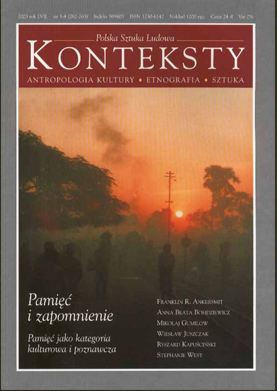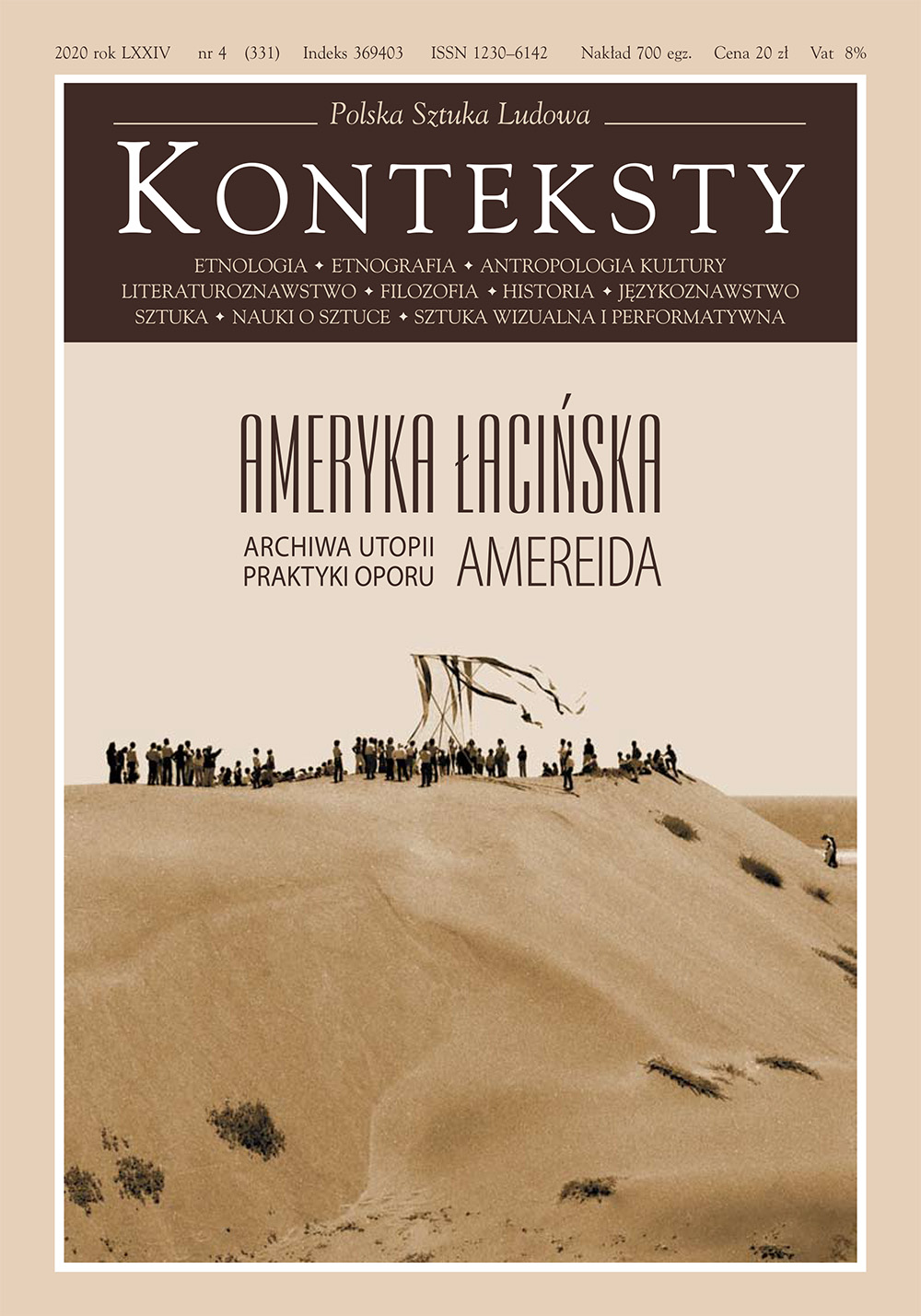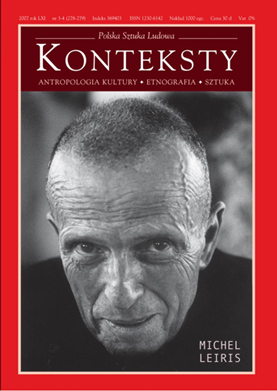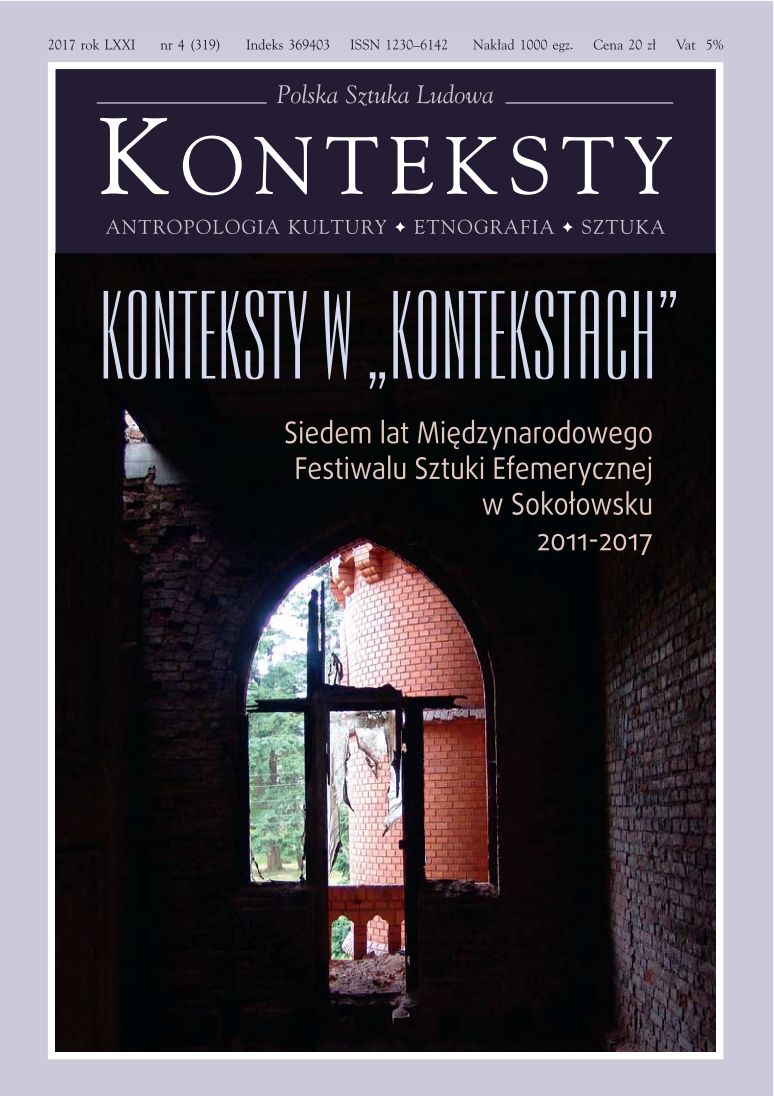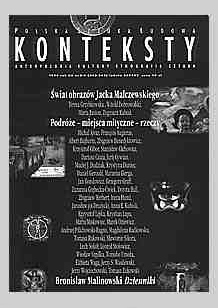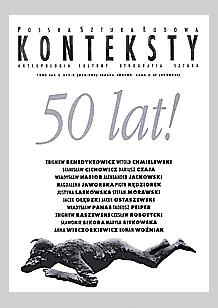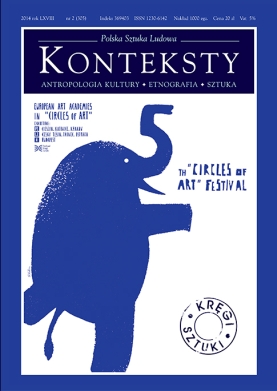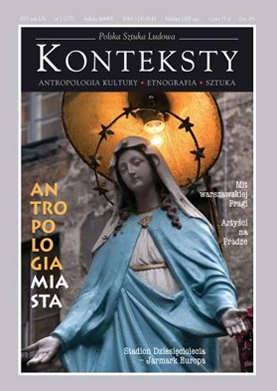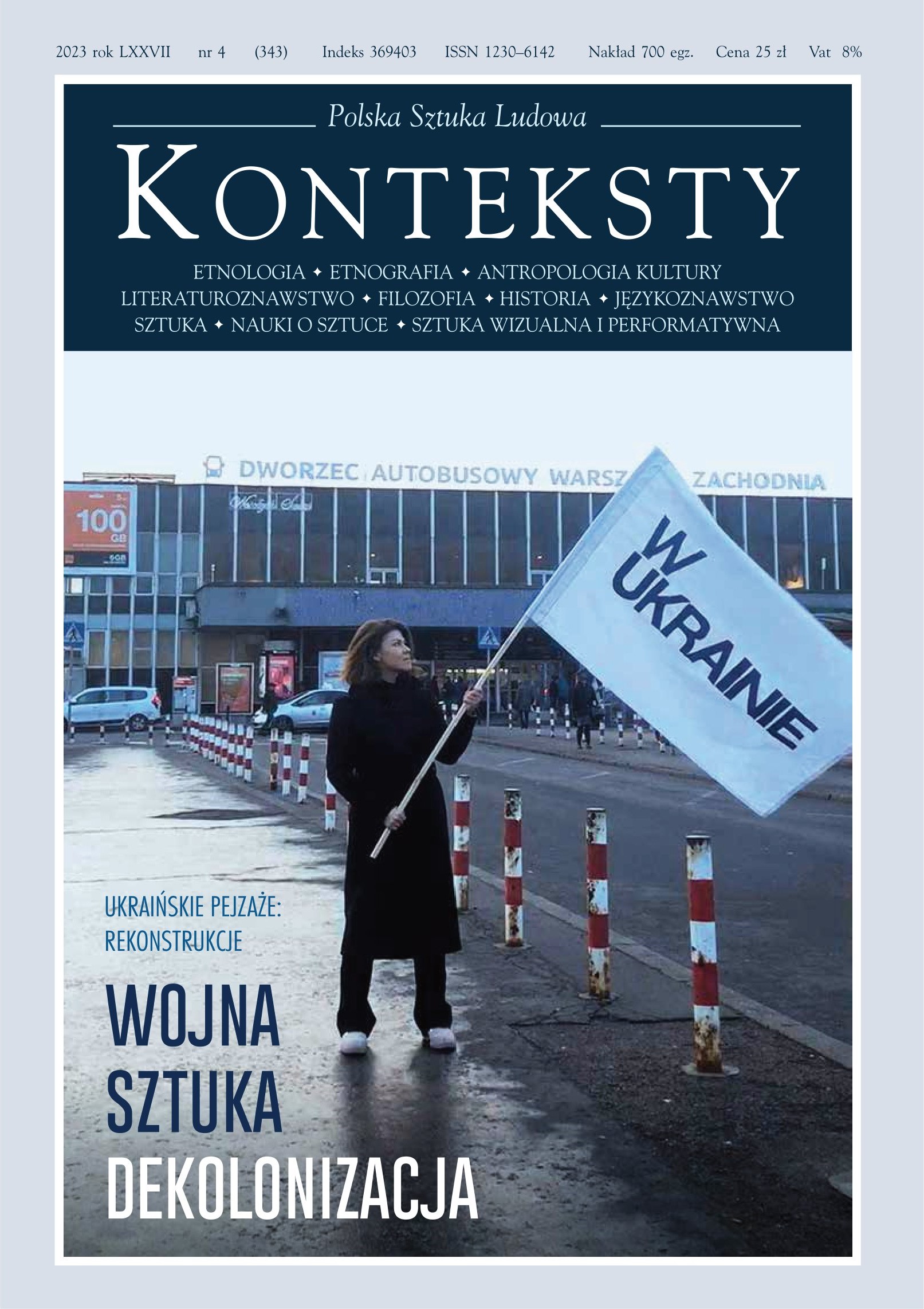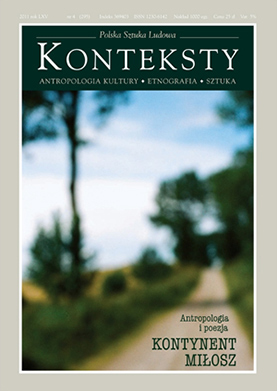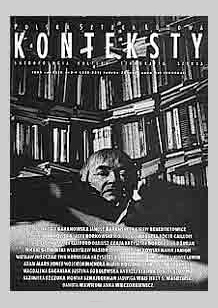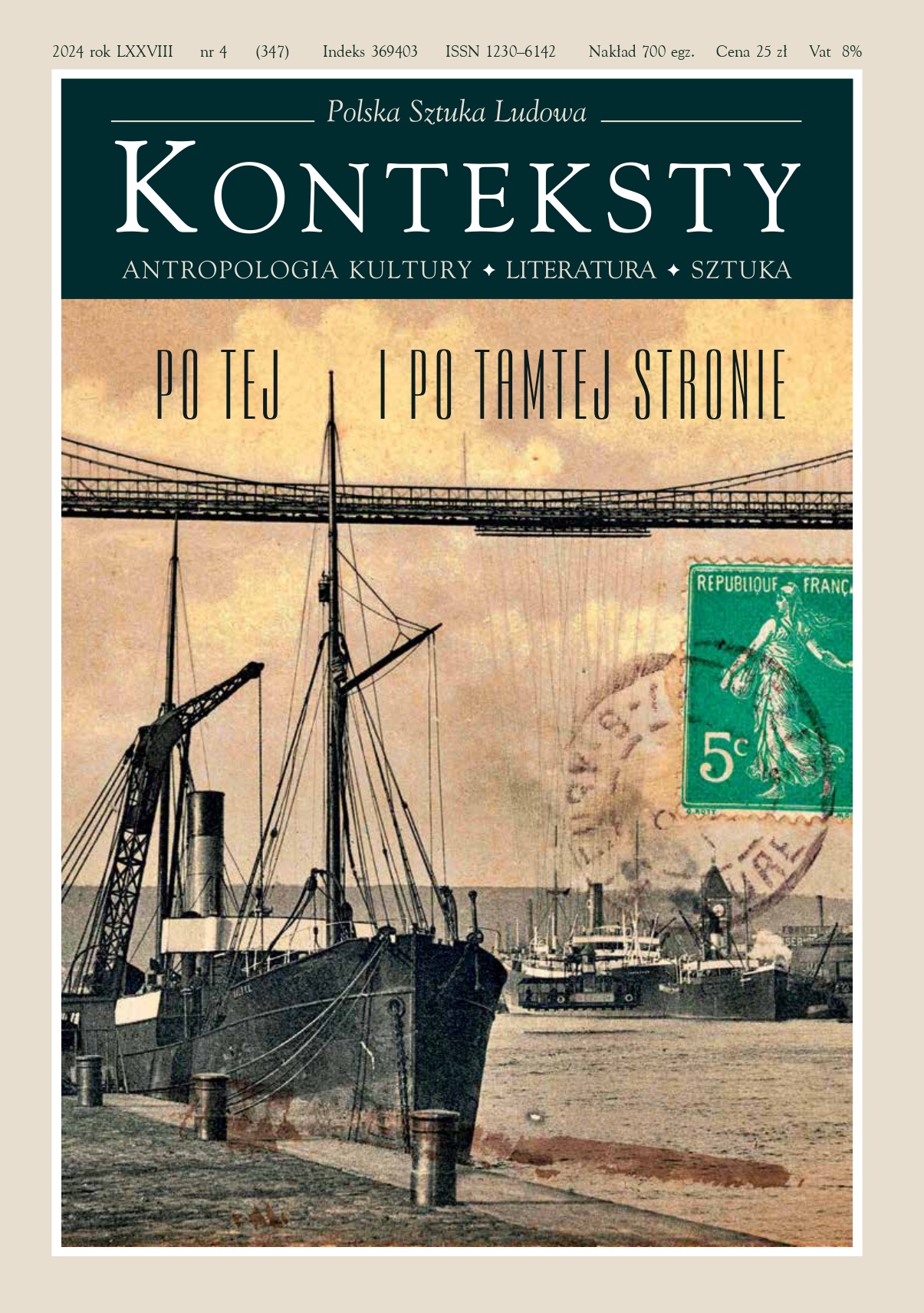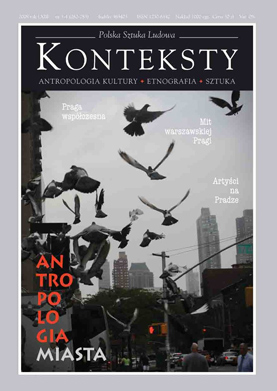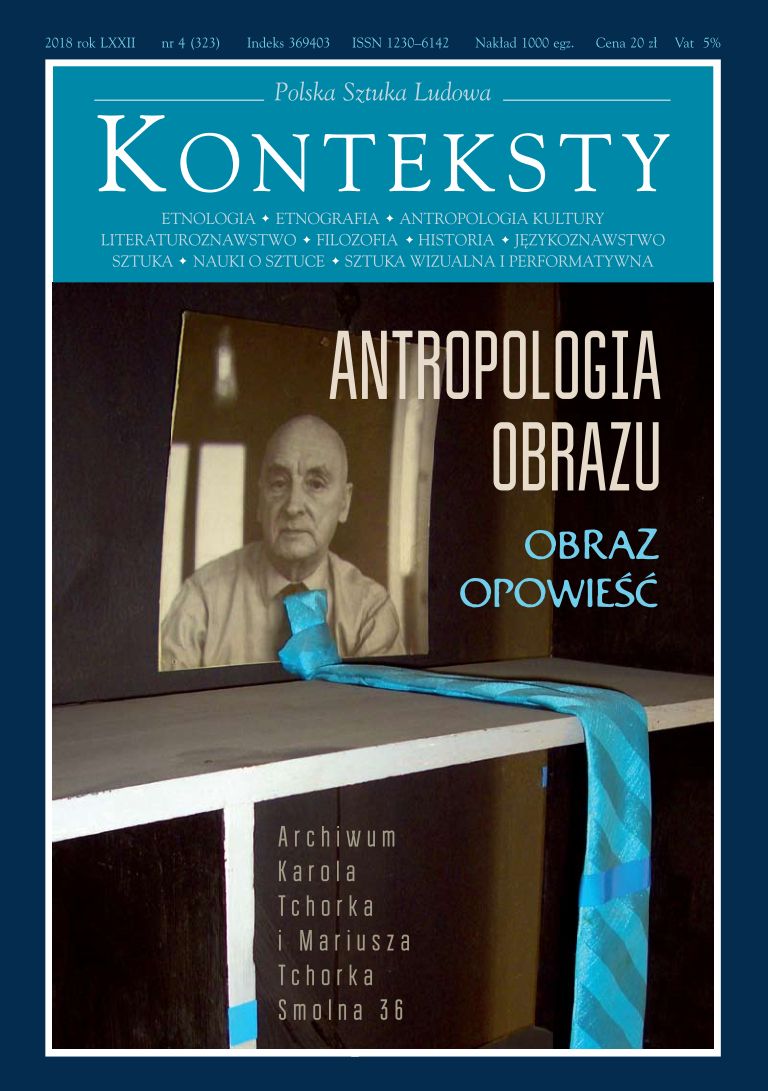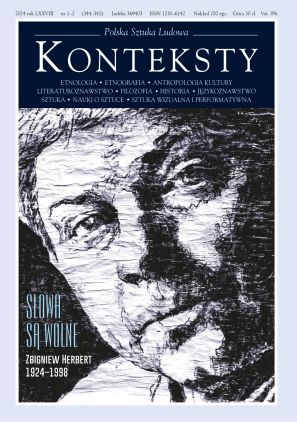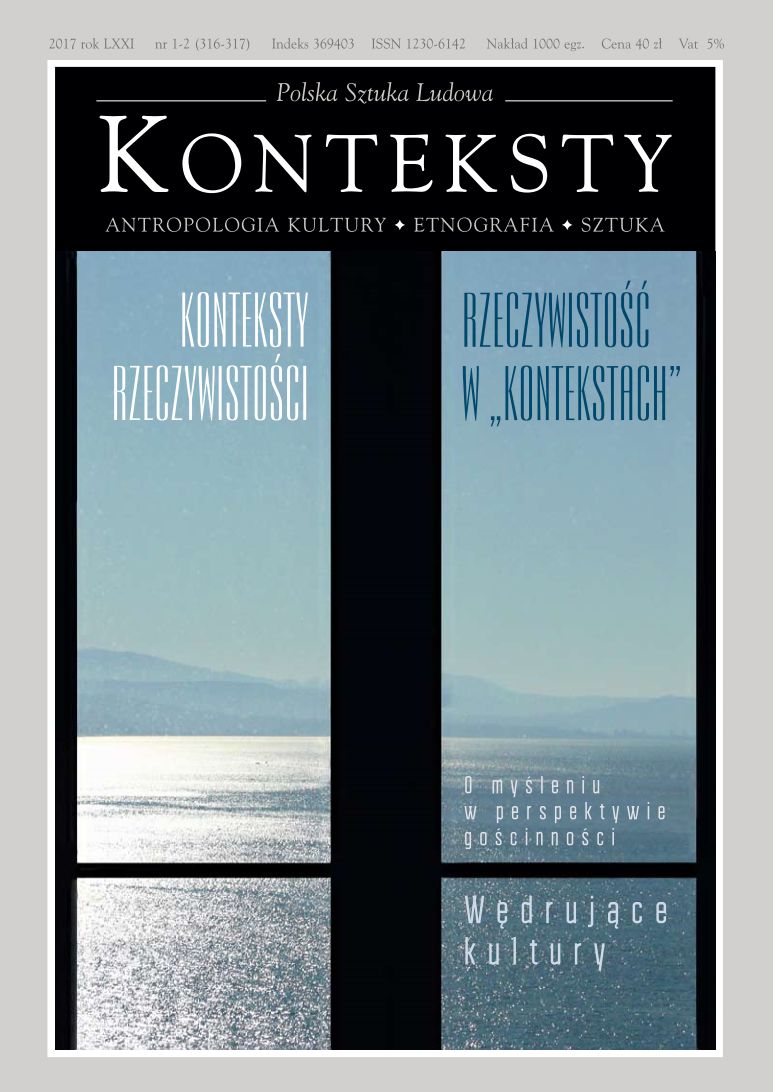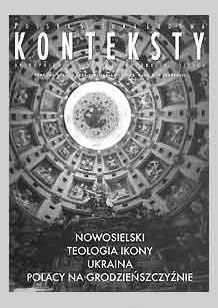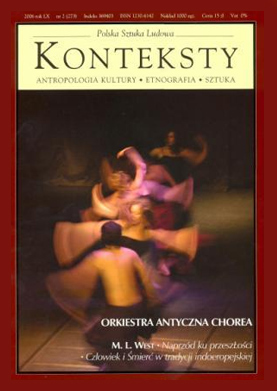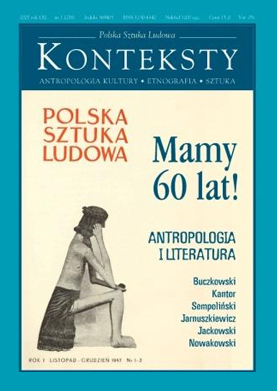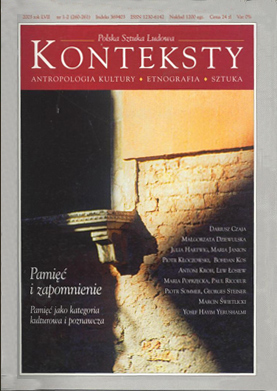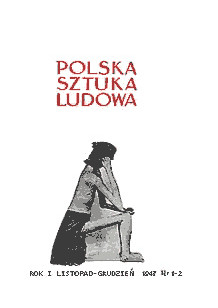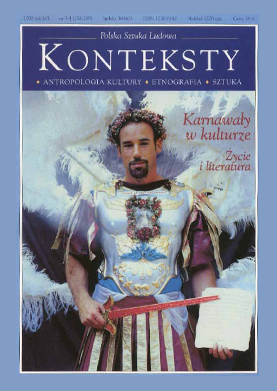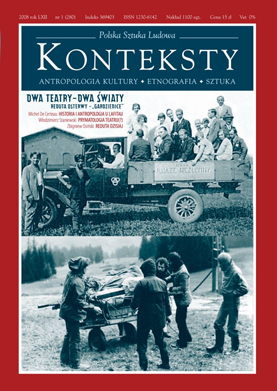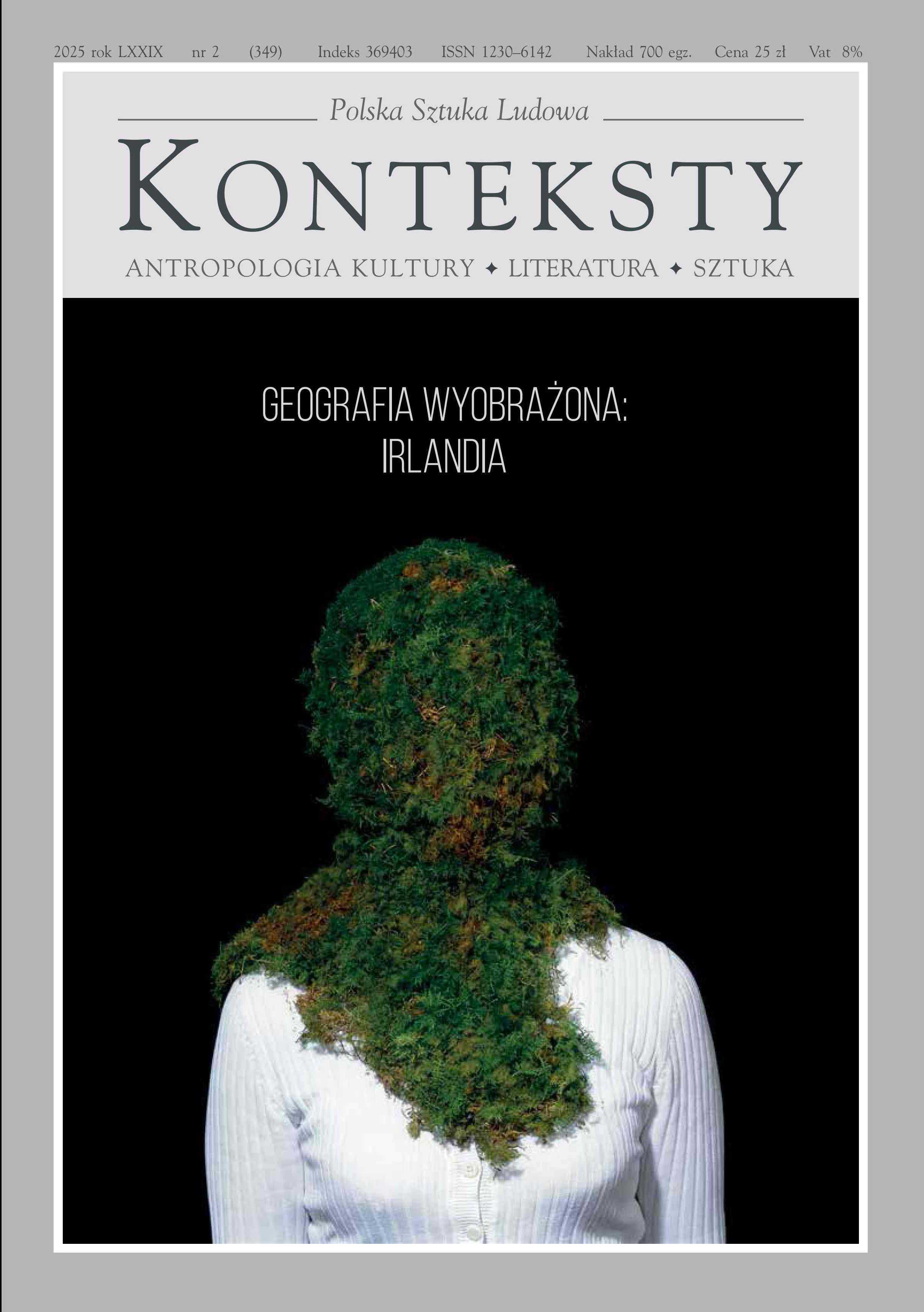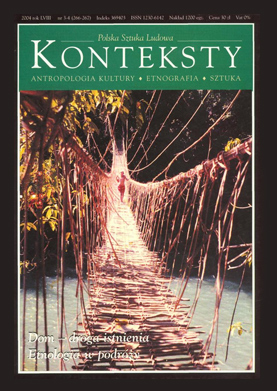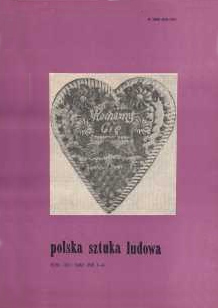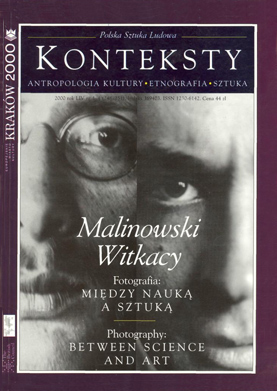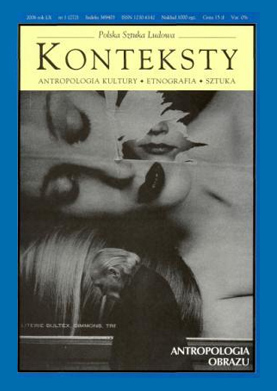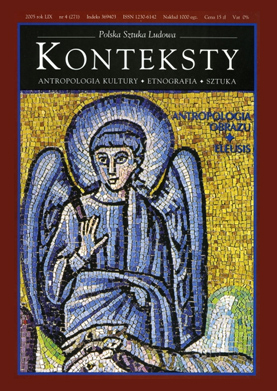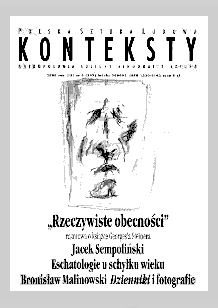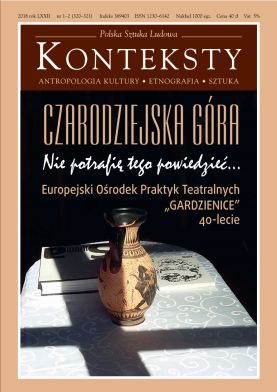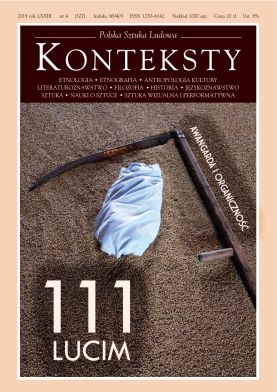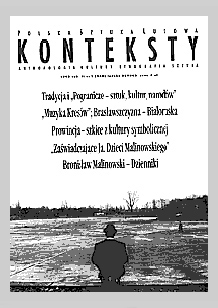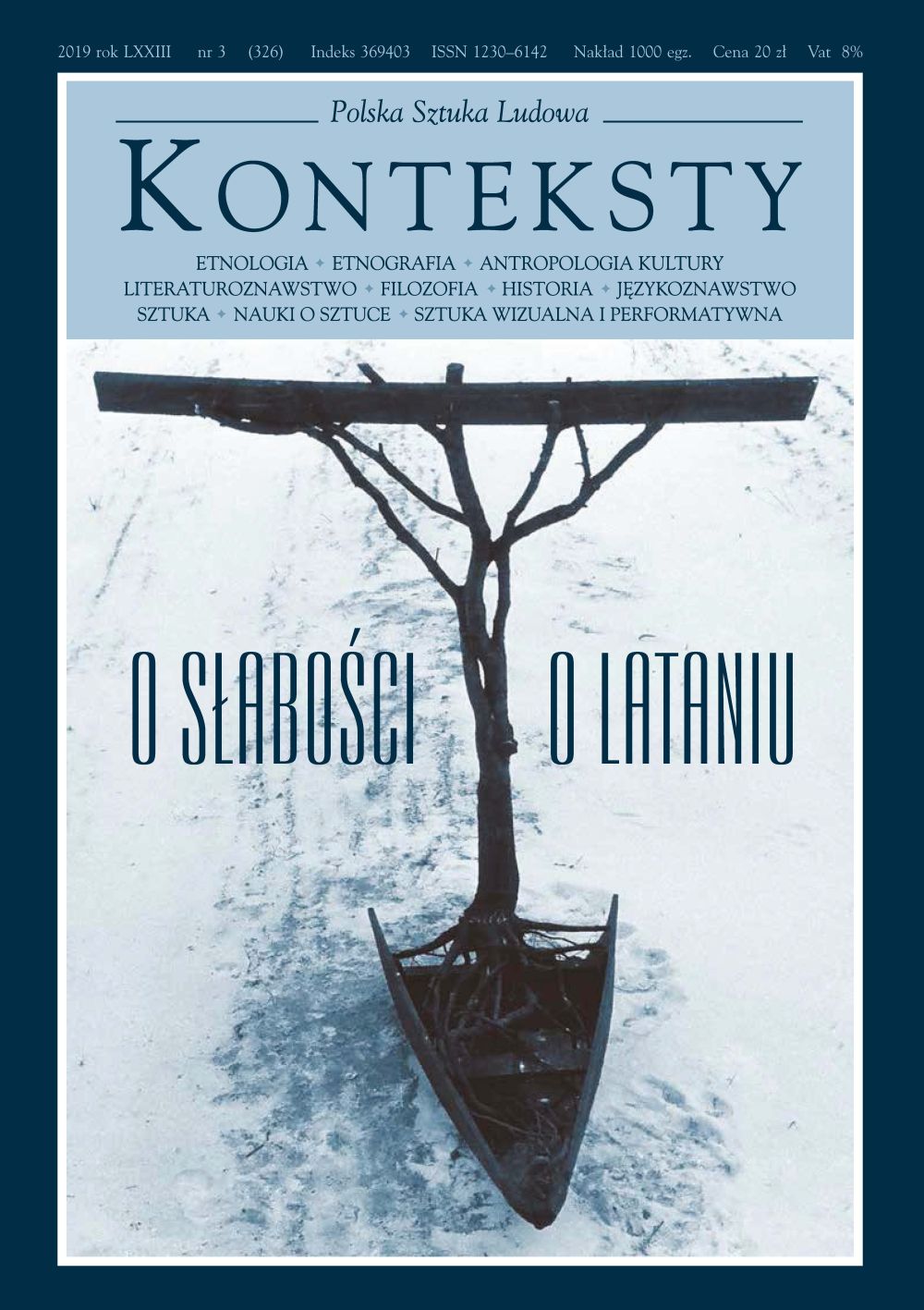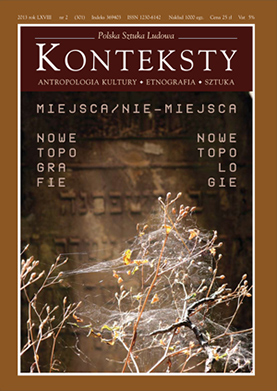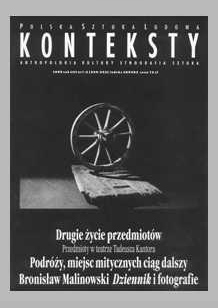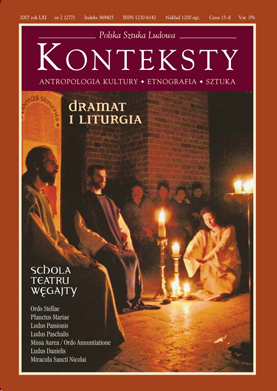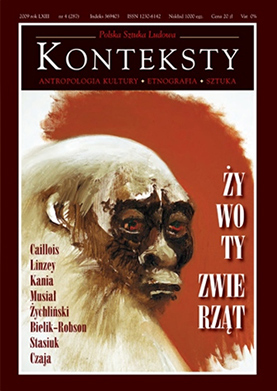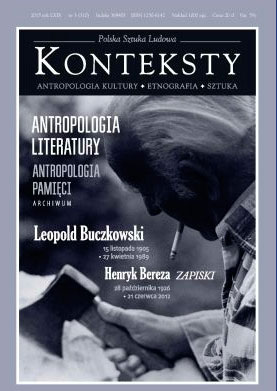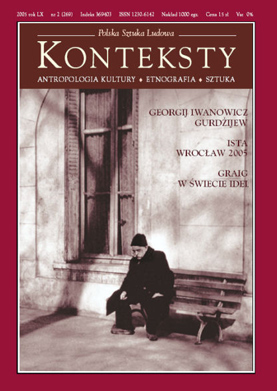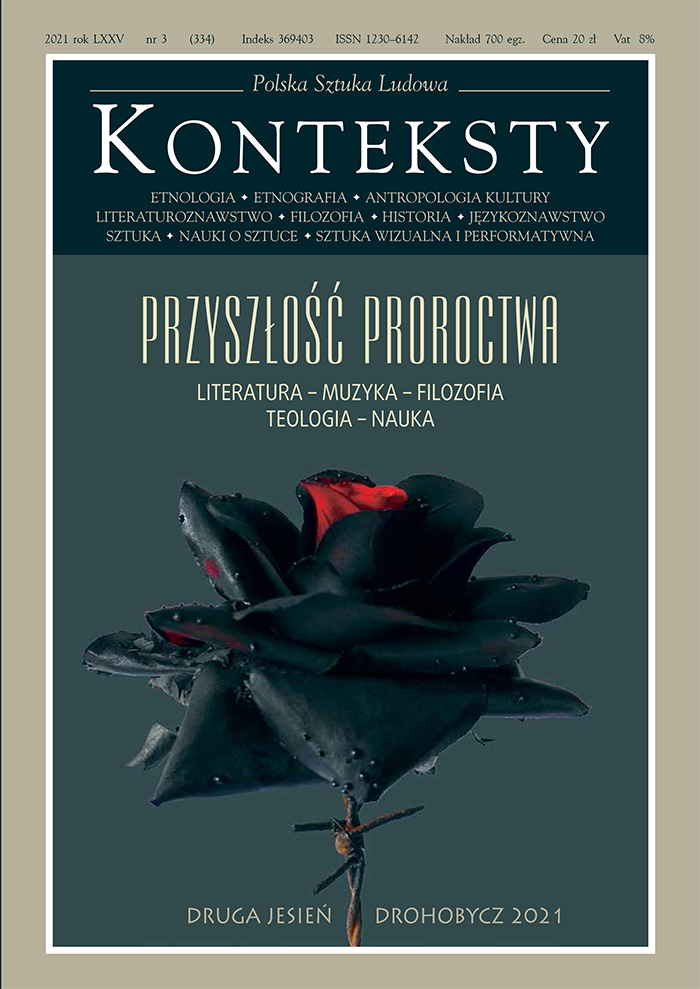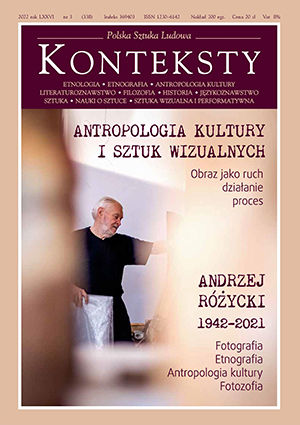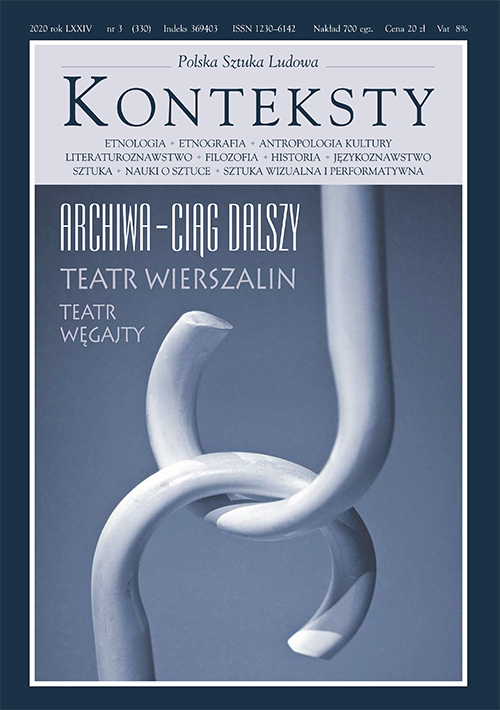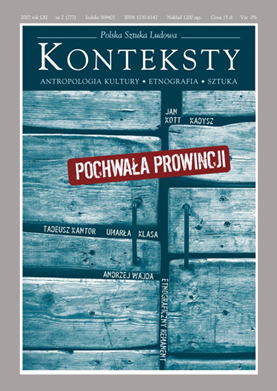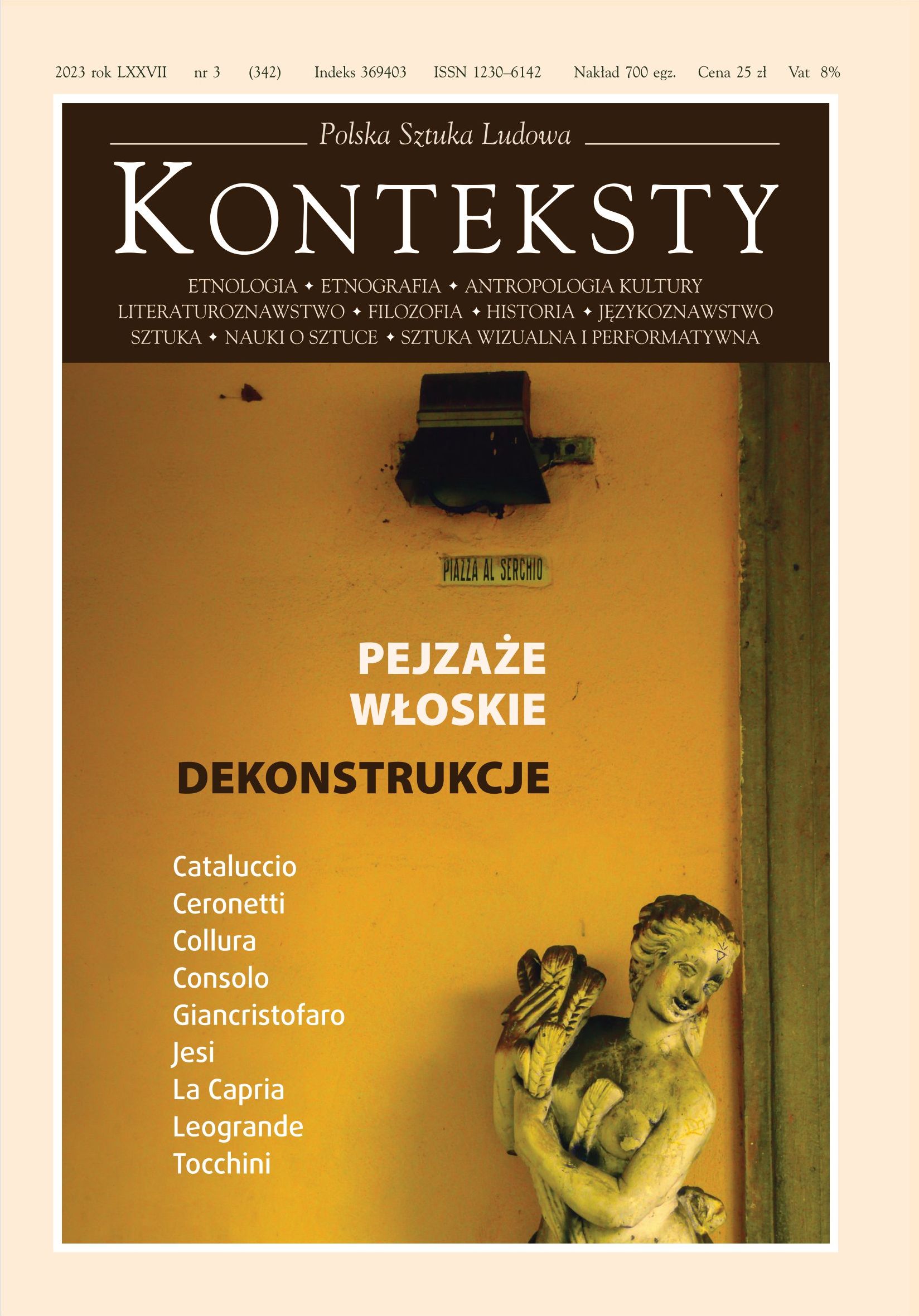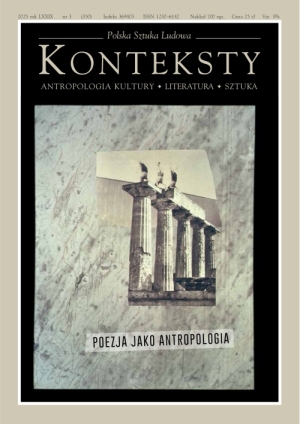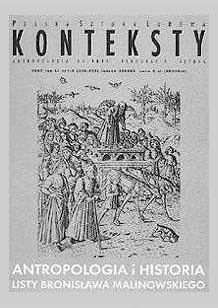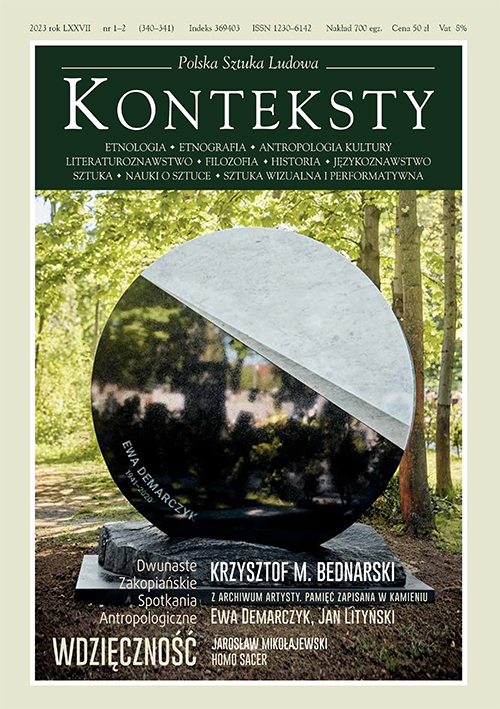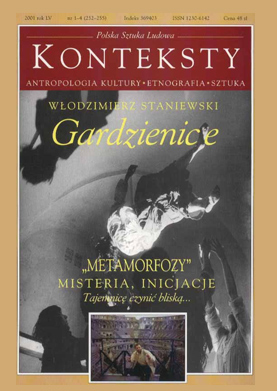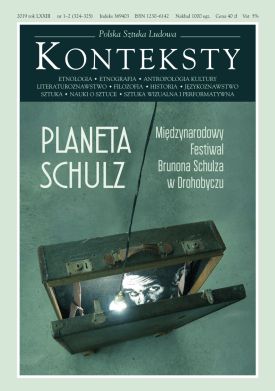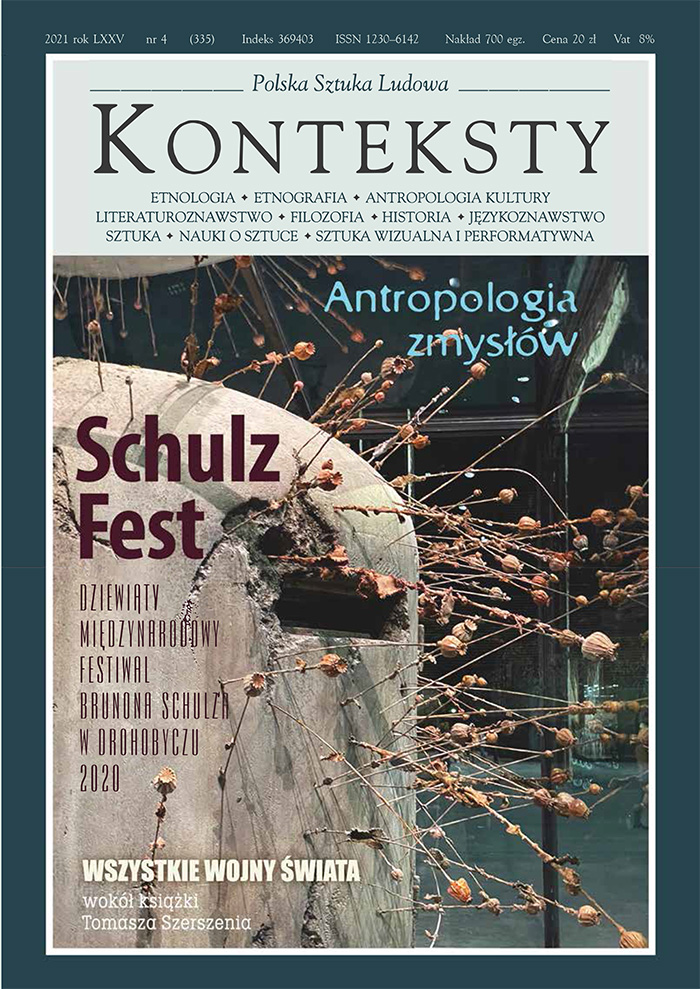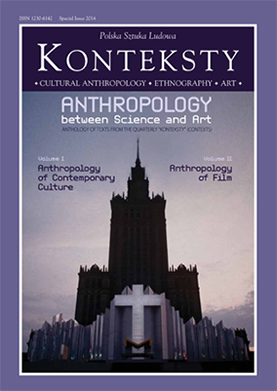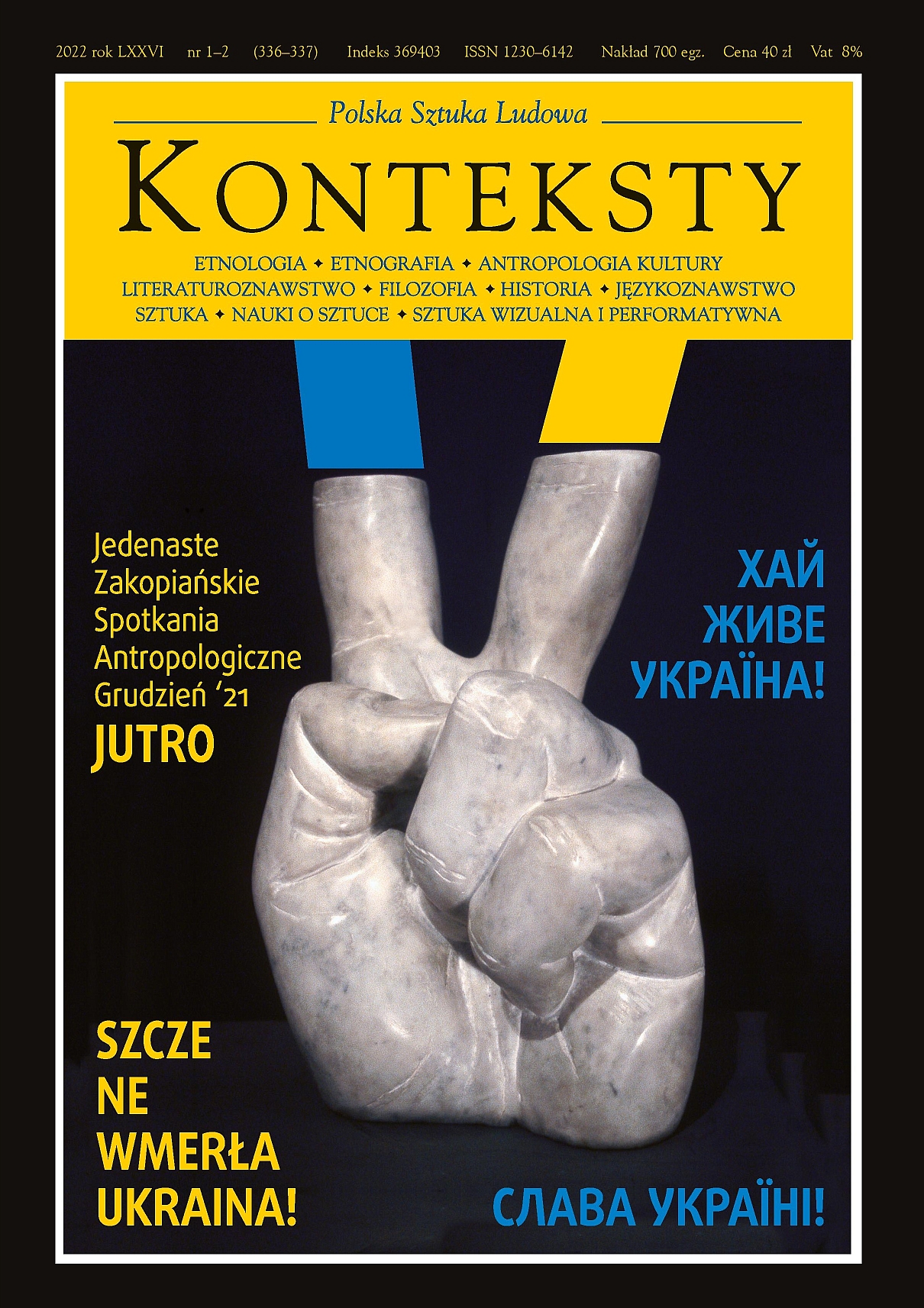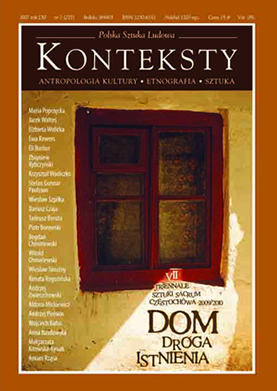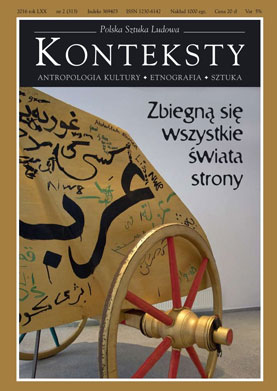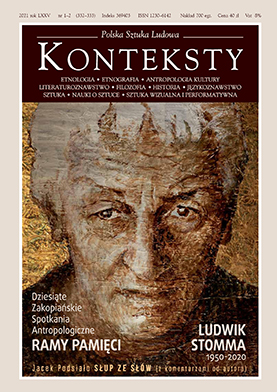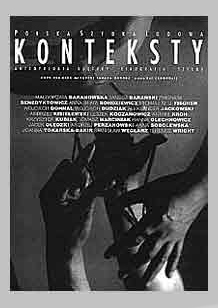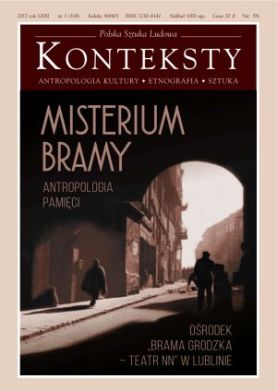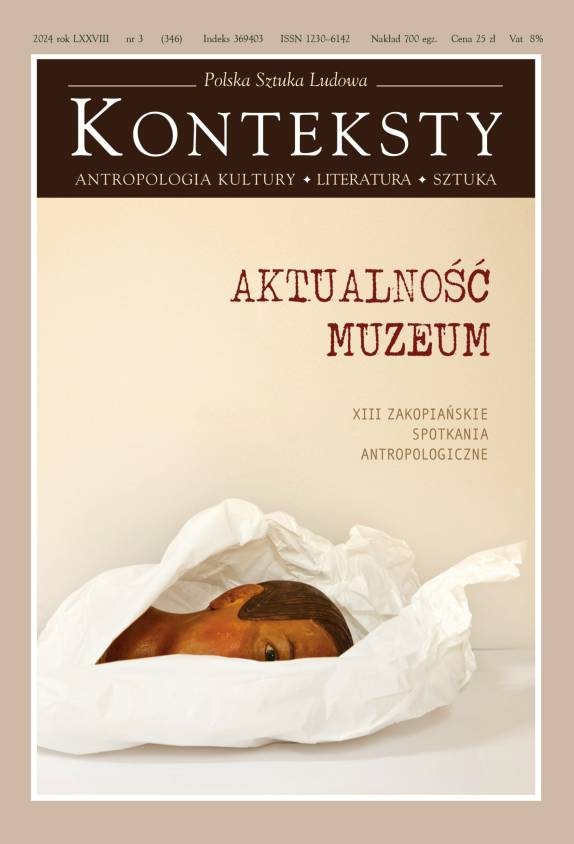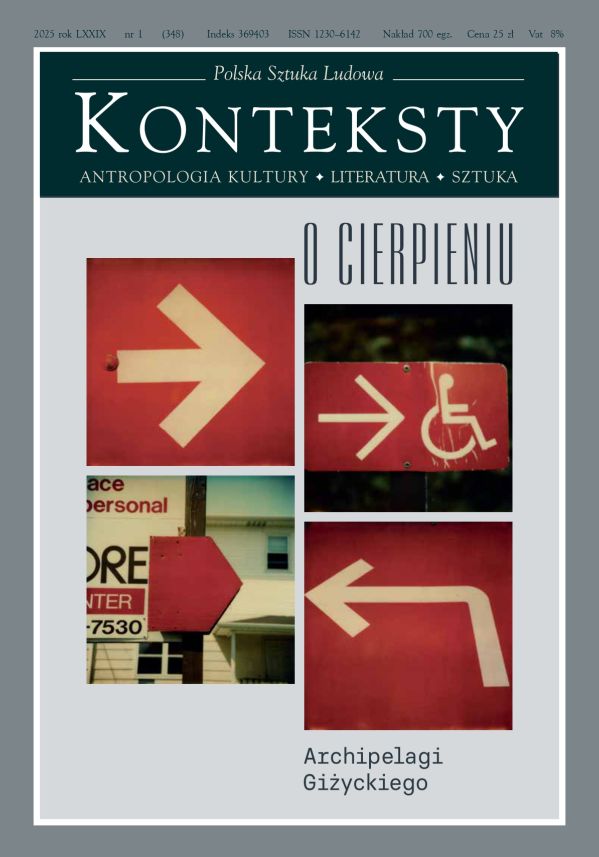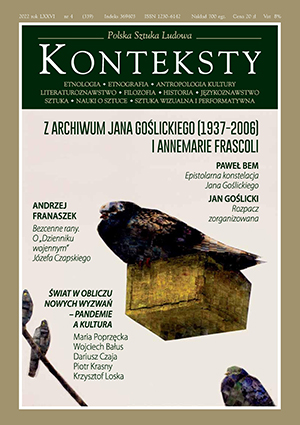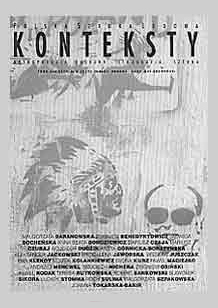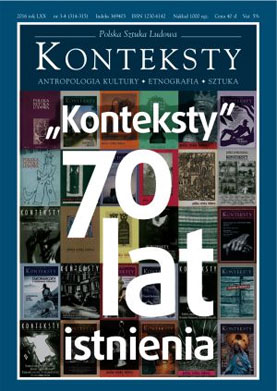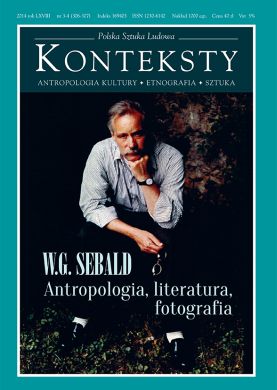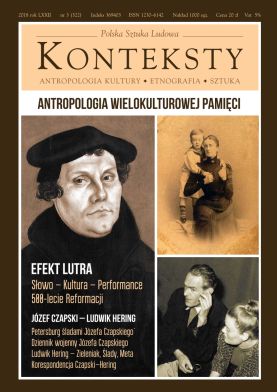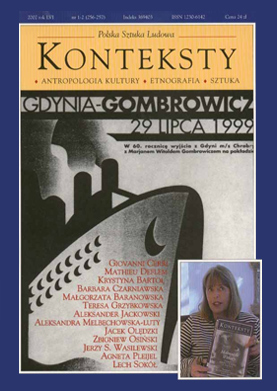Issue 2015/4 (311) -
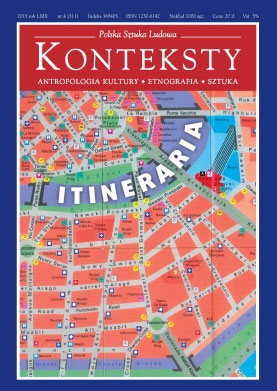
| Magdalena Barbaruk, Dariusz Czaja | Itineraries | 3 |
| Carlo Ginzburg | Tusitala and his Polish Reader  | 8 |
This text by Carlo Ginzburg analyses the complicated fate of the leitmotif of Robert L. Stevenson’s ‘The Bottle Imp’. It enabled Italian historian to discover astonishing links between fiction, reality, and scientific cognition, and to formulate a daring theory claiming that Bronisław Malinowski would have not formulated his most famous scientific thesis if he had not earlier read Stevenson’s story. In other words, the expedition to the Triobriand Islands would have not been realised in the cognitive sense were it not for the knowledge provided by literary fiction. | ||
| Arkadiusz Żychliński | The Settled Traveller. The Topography of Fiction  | 19 |
The article proposes a general typology of narrativised journeys so as to deal in greater detail with a selected sub-category of literary fiction, in which the journey is a backdrop extracting the metaphorical potential of the voyage. The processes of adopting fiction and overcoming space share a curiosity of experience and are seemingly divided by the course of achieving it. An analysis of three model-like examples of meta-fictional anthropofiction (by Franz Kafka, Antonio Tabucchi, and Roberto Bolaño) makes it possible to consider arguments both confirming the correctness of such an identification and doubting it, and subsequently to devise a conceptual framework allowing a more general interpretation of the universal category of the truth of experience. | ||
| Krzysztof Łukaszewicz | About a Journey to the World of Literature  | 26 |
War das Dichten will verstehen, /Muß ins Land der Dichtung gehen, /Wer den Dichter will verstehen, /Muß in Dichters Lande gehen – this is the motto of a number of remarks formulated by Johann W. Goethe to guarantee a better understanding of his collection of poems: The West-Eastern Divan.An analysis of the contexts whose impact gave rise to the motto, and a pursuit of questions whose posing it provoked, lead to such issues as pictorial qualities, Orientalism, world literature, and translation. Goethe the poet, the prose writer, and the scholar argued that a skilful and creative use of linguistic means opens up towards oneself and the world, while a voyage to the world of literature is tantamount to a voyage across the world. | ||
| Dariusz Czaja | Real Fictions. Following the Text  | 35 |
Reading is a very mysterious and complexed process. It’s a very creative act and of cognitive value, as well. No one knows what really happens in our minds while reading. Following the literary text can be compared to a specific journey. Theme of the Traitor and Heroby Jorge Luis Borges is a departing point of the presented text. Then, the author switches to The Spider’s Stratagemby Bernardo Bertolucci, the film, which is based on Borges’ short novel. And the final stage of this imaginary/real journey is Sabbioneta, very small lombardian city, in fact: la citta ideale,built in XVI century by Vespasiano Gonzaga. In this moment palimpsest-like narration of the article is fully completed. | ||
| Rafał Nahirny | Bruce Chatwin along the Paths of the Song of Creation  | 48 |
The author of this article analysed the manner in which Bruce Chatwin constructed the landscape of Central Australia in his The Songlines. With this objective in mind he described the process of humanisation characteristic for the Australian interior and took a closer look at the obstacles encountered by the English traveller attempting to understand Australian dreaming tracks. The author claims that the unexpected and authentic meeting between Bruce, the lead protagonist of The Songlines, and the indigenous Aborigines took place at the precise moment when the former abandoned his cognitive ambitions. Consequently, Chatwin’s book delineates a specific literary trail, which postulates veering from the previously chosen path for the sake of ”wandering”. | ||
| Anna Chęćka-Gotkowicz | “A Stranger I Arrived a Stranger I Depart”. Musical Peregrinations in Incomplete InfinityLandscapes  | 54 |
As a universal way of thinking music holds promise of coming closer to inexpressible experiences. That, which cannot be captured via conceptions reveals itself to the performer (and the listener) in solitary existence amidst sounds. Upon occasions, the existential journey into the self - as long as it is granted a social signature thanks to artistic means of expression - changes into poignant interpretation, which expands the field of comprehending not only music but also existence as such. This is the sort of reflection that the listener is invited to pursue by the music of Schubert, marked with the idiom of a journey of despair. In the presented text this trail was followed by such interpreters of Schubert’s works as the essayist Pascal Quignard, the musicologist Charles Fisk, the poet Stanisław Barańczak, and the pianist Sviatoslav Richter. By listening closely to Schubert and by following in his steps they reconstructed the composer’s wanderings and opened up new horizons for the meaning encoded in his music. | ||
| Magdalena Barbaruk | Errant Maps  | 62 |
The point of departure for the reflections pursued by the author of this article on the uniqueness of literary routes is a documentary film – Errant Maps (screenplay by Magdalena Barbaruk, directed by Szymon Uliasz, 2014) made by following the trails of Don Quixote. The film provides material for presenting the visualness of the tracks, both as regards the selection of tools that ought to be applied for examining and depicting such trails as well as issues of fundamental significance, associated with the necessity of being in places and participating in literary landscapes. With this purpose in mind the author recalled the conception of the “construction of the place” formulated by Ignatius of Loyola (Spiritual Exercises). The analysis focuses successively on the most essential visual forms of literary routes: photography, the cinema, and maps. The article ends with deliberations about wandering/erring, which the author believes are a metaphor of following a literary trail and which in the text obtained an axiological qualification. The literary route as such is defined as the reader’s way of life moulded by assorted values connected with the literary work, whose scenery is a landscape conceived as one of the symptoms of culture. | ||
| Zoriana Rybczyńska | The Voyage as a Tale: on Transmissions between the Text and the Landscape  | 74 |
The author tries to look more closely at the way the lecture Agnon’s novel Guest for one night and translate into the spatial practices. In addition, she based on the text of the novel reconstructs the imaginary topography Buchach (in the form of narrative maps) that is deeply entwined with sensory codes of forming a separate level of experience space and creating cultural landscape. These factors are important in the design of the possible tour routes (Agnon routes), and also to establish the general Buchach imagology. | ||
| Piotr Jakub Fereński | Fictional Maps and Holy Topographies  | 82 |
Literary rites possess a complex ontology and numerous ways of tackling the differently comprehended topography of reality. Naturally, it is possible to envisage a literary rite following the steps of Alice traversing the Wonderland, but the majority of such tracks leads across places for which empirical qualities are much more important than in the world portrayed by Carroll. The author of this article assumed that by tracing “maps” of the physical world literary fiction becomes primary vis a vis the former or outright establishes it. In this particular instance the empirical substance of reflections on ties between literature, topography, and memory consists of French journeys to the Holy Land, i.e. Itinéraire de Paris à Jérusalem by François-René de Chateaubriand and Voyage en Orient by Alphonse de Lamartine. The fundamental theme of the article consists of relations between literary texts depicting travels and the creation of likenesses of holy places in collective memory. With this purpose in mind the author evoked and discussed the views of Maurice Halbwachs, expressed in La topographie légendaire des évangiles en Terre sainte. | ||
| Xavier Farré | Exiles and Returns. On André Aciman  | 90 |
Is it possible to recreate memory that reached us solely via the language? Is it feasible to recreate a place upon the basis of recollections and suppositions, and to what degree can the ensuing result bring us closer to some sort of reality? Finally, to what degree is our misleading memory capable of confronting a different memory about a given place, produced within the range of exactly the same space as the one that has vanished? In his essay: Barcelona, published in the collection: Alibis: Essays on Elsewhere, André Acimen traversed various parts of a town that once contained a Jewish quarter (El Call) and sought traces of his lineage - the presence of Sephardic Jews exiled from fifteenth-century Spain. But what was he really looking for? A confrontation with reality opens up quite a different dimension of a place. Everything is imaginary - imagined by the author and implicit in the case of the town (or rather the city authorities who recreated this place artificially for the tourists). These memory-literary trails in an essay in which the border between fiction and biography is infinitesimal seem to ask us whether fiction (dealing with trails) shapes our memory about ourselves and places and becomes a more authentic image despite the fact that it is illusory. | ||
| Adam Wodnicki | Arles  | 94 |
A personal postscript to the Provençal series: Tryptyk oksytański (Notatki z Prowansji, Obrazki z krainy d’Oc, Arelate. Obrazki z niemiejsca), containing the author’s self-reflection about the simultaneously functional and real nature of the world described by him. | ||
| Agnieszka Karpowicz | Topo-Graphy/ics in/of Motion. Miron Białoszewski’s Art of Walking  | 97 |
This text proposes an analysis of the art of walking conceived in the prose of Miron Białoszewski as a carrier of literary meanings. By extracting the functions of walking as a cultural activity A. Karpowicz embarked upon a reconstruction of the conception of space and the methods of becoming acquainted with it in Białoszewski’s oeuvre. In doing so, he came across their concurrence with anthropological conceptions of space and methods of studying urban space, focused on the practices of walking (the anthropology of daily life according to Roch Sulima, the visual ethnography of Sarah Pink, and the integral and creativity-oriented approach represented by Tim Ingold). This interpretation made it possible to indicate the superior importance of the practice of walking – the creation of a continuum - in writings by Białoszewski. | ||
| Paweł Próchniak | Itinerary of Poems Notes from Journeys along the Trail of Poemat o mieście Lublinie  | 107 |
Poemat o mieście Lublinie, written by Józef Czechowicz in 1934, is musical score of sorts. Its realisations (a radio programme conceived by the poet, successive strata of interpreting Poemat ... as a literary text, actual expeditions across Lublin along the route described in the poem) provide each other with various options of reading the text and associated registers of meanings; in doing so they expand and render nuanced the complex (semantic, imaginary, existential) inner potential of the poem, which is a certain form of memory (Czechowicz used the term: ”recollection”) and which inserts memory-recollection into the town’s topography. This gesture performed by the poet and the permeation of an imaginary trail and an actual itinerary are the object of the reflections pursued by the author of this essay, which is another sort of wandering involving the imagination, thoughts, and writing. | ||
| Krystian Darmach | The Fernando Pessoa Code. The Lisbon Treatise, or What Should the Tourist Never See in Lisbon?  | 114 |
Pessoa and Lisbon. A manual. An odyssey of the imagination. Information indispensable for getting to know Lisbon and superfluous for experiencing it. Is it possible to rid experience of all sorts of literary borrowings, not to mention cultural ones? What would be the effects, gains, and losses of such a striving? The author attempted to answer these questions by delineating a map of the territory of impacts on the way, and involving himself, Lisbon, and Pessoa. By following the traces of our encounters, evasions, permeations and dependencies. By cultivating a t(r)op(e)ography of assorted dimensions of joint presence/absence, and by indirectly taking into account the rarely discussed Pessoa guidebook to Lisbon. | ||
| Blanka Brzozowska | Wandering across the Subterranean Town – the Universe of In the Metro and the Anthropology of the Metro as Inspirations of Flânerie  | 120 |
A presentation of an extraordinary image of a town that emerged in the course of flâneur explorations of subterranean metro tunnels. The point of departure for these reflections is the anthropology of the metro proposed by the French scholar Marc Augé, whose work is situated along the borderline of anthropology and literature and portrays the metro as a fascinating field of research for the anthropologist and, at the same time, as a “memory machine” blending collective History and the individual histories of daily travellers (including the researcher). In turn, literary inspirations, exemplified by a series of books inaugurated by Metro 2033, a novel by Dmitry Glukhovsky, provoke readers-flâneurs to embark upon sometimes hazardous journeys into the underground recesses of a city in a search for mysteries created by a tangle of historical facts, rumours, urban legends, and the imagination of the town dwellers. | ||
| Jan Gondowicz | To Get Lost in a Palimpsest  | 127 |
Reflections pursued in this article are based on the so-called Prague trilogy by the Czech writer and philosopher Michal Ajvaz: Murder in the Intercontinental Hotel (poems, 1989), Return of the Old Komodo Dragon (stories, 1991) and The Other City (a novel, 1993). The common denominator of these books is a private and extremely evocative myth maintaining that the underpinning of present-day Prague and its environs is composed of an ancient phantasmagoric civilisation whose secrets can be penetrated either by chance or quite intentionally. The actual topography of the city, its edifices and homes, is delineated by secret passages, which together with the props of the “other town” mark a route of the narrator’s constant wanderings, and from time to time, and then ultimately, guide him “to the other side”. The narrator, in pursuit of the “other town”, becomes slowly ensnared in a centre-less labyrinth, a metaphysics of impassable peripheries. | ||
| Walentyna Krupowies | Age of Root Voyages  | 132 |
The author focuses on the ways in which Vilnius is remembered and reconstructed by some of the most prominent Polish writers raised in that place, i.e. in the poems of Czesław Miłosz. The image of the city, remembered as an idyllic space of childhood, undergoes various metamorphoses – it is transformed by memory and nostalgia, and confronted with reality only after several decades. In her text Walentyna Krupowies analyses the complex work of memory and oblivion in the process of shaping of the literary image of the place and carefully re-reads some of the classic texts of Polish literature of the past century. | ||
| Paweł Sowiński | Itinerant Tradesmen. How We Travelled Abroad  | 140 |
A presentation of the culture of the distribution of goods in People’s Poland and a synthetic interpretation of itinerant trade from an historical perspective. The article, situated within the current of trans-frontier and trans-cultural studies, indicates both grassroots factors and the institutional context. Heretofore research dealing with post-war Europe firmly emphasised the significance of the division of the Continent into two isolated parts. Without completely negating this thesis, the author pointed to a systematic permeation of ideas and culture across the Iron Curtain and pondered the course of this expansion of the Western world in the conditions of a peripheral country and the political hegemony of communism. | ||
| Petro Murianka | And Vistula Still Flows… To Describe Life  | 147 |
The published fragment comes from a volume of childhood reminiscences: A Wisła dalej płynie. | ||
| Marian Pilot | The Bethlehem, Nazareth, Jerusalem, Jericho and Mikstat Gap  | 154 |
A pilgrimage? I am quite willing to go on a pilgrimage to Mikstat for the feast day of St. Roch (16 August). Pious women, however, urge me: forget St. Roch! A proper pilgrimage is the one to the Holy Land, along the trails of the Lord Jesus, and under the guidance of the Pallottine Fathers! I have my doubts and hesitate. I might like to set off for the Holy Land and walk in the footsteps of the Lord Jesus, but shall l I be able to to do so, will the task not surpass me? Have I earned such a privilege? Has my life been sufficiently exemplary? | ||
| Henryk Bereza | Letters from Italy 1978 | 163 |
| Tomasz Szerszeń, Paweł Mościcki, Jan Gondowicz | Journey without a Map and Passport – a Recorded Conversation about a Book by Tomasz Szerszeń  | 166 |
This conversation about Podróżnicy bez mapy i paszportu. Michel Leiris i ”Documents”, took place on 18 June 2015 at the Museum of Modern Art in Warsaw. | ||
| Maria Poprzęcka | The Rebellion of My Inner Person  | 174 |
An essay about paintings by Jacek Sempoliński (1927-2012). | ||
| Jan Słoniewski | Motifs of Jewish Mysticism in the Works of Anselm Kiefer  | 184 |
Recently, the oeuvre of the German artist Anselm Kiefer, brimming with references to historical events, Germanic, Nordic, Egyptian, and Middle Eastern mythology as well as assorted religions features intensified interest in Jewish mysticism. The intention of the author of this article is to decode the artist’s particular works explicitly referring via the title or the visual stratum to ideas derived from the written sources of the Kabbalah (The Book of Creation, Etz Chaim) as well as those preceding them (Hekhalot). Particular conceptions of Jewish mysticism present in the works of Anselm Kiefer – the journey across seven celestial palaces and communing with the Throne of God, His emanations (Sefirot), the female element (Shekhinah), the Tree of Life, the pre-catastrophe (shattered vessels), God’s withdrawal (tzimtzum) and the rectification of the world (tikkun) – comprise the structural axis of the text and were presented upon the basis of works by Gershom Scholem. A discussion about successive mystical ideas is accompanied by matching them with the artist’s concrete works. The author also proposed to insert into the context of Jewish mysticism those of Krieger’s works that originated before the artist became interested in Judaism as well as those, which literally referred to cultural circles other than the Judaeo-Christian one (e.g. the myth of Osiris and Isis). At the same time, the analysis refers to such themes as material (e.g. lead). The author perceives the presence of the Kabbalah shevira – a mystical catastrophe – in a considerable number of the artist’s works referring to destruction, including those evoking the Holocaust and thus opposing the universally held view linking Kiefer’s oeuvre with a readiness to work through the traumatic lineage of the German nation. | ||
| Bartosz Flak | The Peasant Group Posthumous Portrait  | 194 |
The peasant (group) posthumous portrait is one of the four canons of posthumous photography executed in Poland in the last century. This text attempts to analyse five portraits upon the basis of the specificity of peasant culture. The interpretation is based on the mythopoeic potential of the camera, which assists in telling stories about the passage of time, the changing generations, the transmission of genes and tradition, man’s place on Earth, and the place he goes to after death. | ||
| Dorota Mieszek | Mr. Bartlett’s coffins. Between the Uncanny and the Disgust  | 206 |
The text deals with concept of the Uncanny (das Unheimliche) in context of the (art)works presented between 2011 and 2013 within the four-part project secret universe run by the Berlin’s Hamburger Bahnhof. To present my identifications concerning the notion of the Uncanny I am referring to Bartlett’s oeuvre. For nearly thirty years, he has been following his passion for the Uncanny. Bartlett has developed an extensive and intimate practice of creating dolls, from carving their shapes through designing the entire wardrobe, to performing the dolls live-like, narrative acts which he then photographed and put aside. Bartlett’s mysterious family is an excellent foundation for the analysis of the Uncanny concept initially introduced by Sigmund Freud in his 1919 essay Das Unheimliche. I will also investigate the category of Disgust as used by Sara Ahmed in her essay The performativity of disgust and inquire, which emotion / affect, uncanny or disgust, is more adequate for describing Bartlett works. | ||
| Henryk Jurkowski | Puppets in Madagascar and on Nearby Islands  | 214 |
The authors of the reviewed book undertook the task of a detective tracing Malagasy customs as well as those of the inhabitants of neighbouring islands. Naturally, myths were preserved and today speak of the creation of man in local conditions. Puppets, however, left behind scarce traces; some are to be found in Swiss and French museums and display distinctive natural features. Old illustrations also testify to the existence of à la Planchette puppets (dancing on a small plank). Extant para-theatrical forms include the theatre of seeds and beads or stories told with stone figures. The theatrical instinct urges the population of the island to create figurines portraying persons encountered in daily life or to adorn a gravestone pillar with statuettes. Other surviving forms include the Ngoma dance performed under a huge hat or funereal games played with the corpse of the deceased. Magic practices using mirror fragments or fertility sticks with female heads have also endured. The former hegemony of the French is recalled in Guignol de Lyon, which, however, does not fulfil noble functions similar to those performed in its homeland. | ||
| Lena Magnone | The First Generation of Polish Freudians – an Attempt at Geopsychoanalysis  | 219 |
Doctor Krokowski from The Magic Mountain by Thomas Mann as well as other examples from inter-war European literature demonstrate that the psychoanalyst in the group consciousness of the period was a Polish Jew. The distinct connection between psychoanalysis and Polishness was the outcome of a considerable representation of persons of Polish origin among the pioneers of the movement: Poles were among the closest collaborators of Freud and in the Vienna Psychoanalytic Society they comprised the second largest group after the Austrians. They also included numerous courageous women who frequently combined psychoanalytical practice with radical socialism and decidedly feminist views. The author of the article outlined a sui generis group biography of this generation of cosmopolitan intellectuals, lay Jews born in Galicia, Poles educated and working in Vienna or Berlin, believing in the cultural and political force of the Freudian project and dramatically aware of the need to change the world or at the very least its sexual and social codes. In this fashion the author showed the way in which the outbreak of the Second Word War affected the fate of the protagonists of the text, condemning them, at the height of their careers, to emigration and starting life anew in entirely different conditions; he also proved that the year 1939 denoted the end of the emancipatory dimension of classical psychoanalysis, which from a Central European cultural project turned into an American theory. The personal successes of the Europeans in their new homeland and the ostensible triumph of psychoanalysis in America conceal its actual end: psychoanalysis assumed medical dimensions and became deprived of feminist and radical features. The resignation by the emigrants of the core of Freudism – a condition for finding employment in the United States – also obliterated its Central European roots. The presented attempt at geo-psychoanalysis entails predominantly following the trajectory of the Polish members of this movement, who at the onset of the twentieth century arrived from the provinces of the Empire to its Viennese capital, and who as a result of World War II once again found themselves on the sidelines, in a psychoanalytical “Wild West”, which in the course of the following decades turned, with their cooperation, into a new centre of the world, thus relegating the former one to the role of a periphery. | ||
| Giulia Guadagnin, Ludwik Stomma | Beneath the Icing | 234 |
| Henryk Bereza | Notes. 1981 II | 237 |
| *** | ||
| Karol Chrobak | Józef Chrobaks Short Biogram | 249 |
| N. N., N. N., N. N. | Józef Chrobaks Bibliography | 251 |
| Zofia Gołubiew | Józik | 254 |
| Anda Rottenberg | Everything Can Be Somehow Useful | 257 |
| Jan Pamuła | Józef Chrobak 1948-2015 | 258 |
| Marek Świca | Józef Chrobak in memoriam | 261 |
| Konstanty Węgrzyn | Józik – an Extraordinary Man | 262 |
| Maria Anna Potocka | Józef Chrobak – a Cultural Detective | 263 |
| Karol Chrobak | Life as a Fascination | 267 |
| Karolina Czerska | A Couple od Words About Józef Chrobak – on the Traces of Tadeusz Kantor | 270 |
| Zbigniew Benedyktowicz | Our Meeting with Józef Chrobak | 275 |
| Marcin Krassowski, Aleksandra Domaradzka, Urszula Klimut, Rafał Rukat | Talk on Mr Józef Chrobak | 276 |



